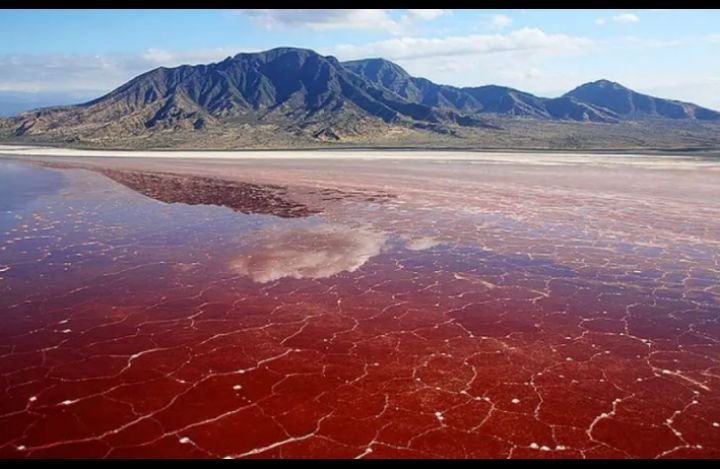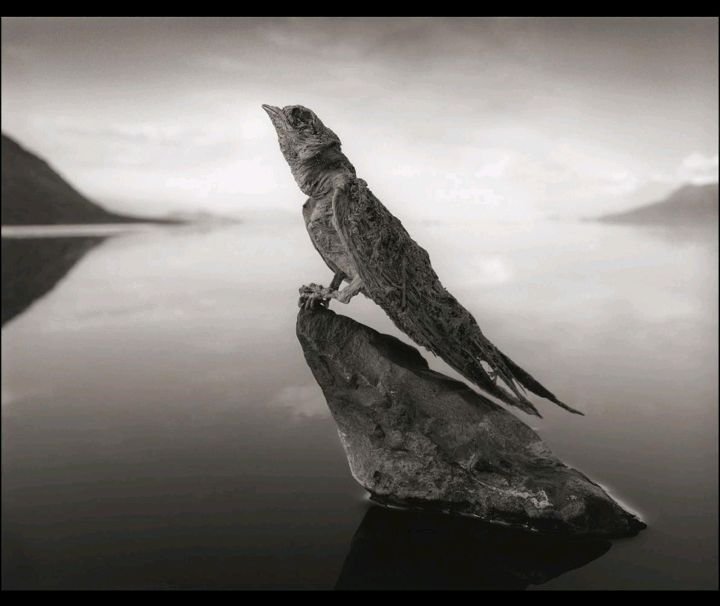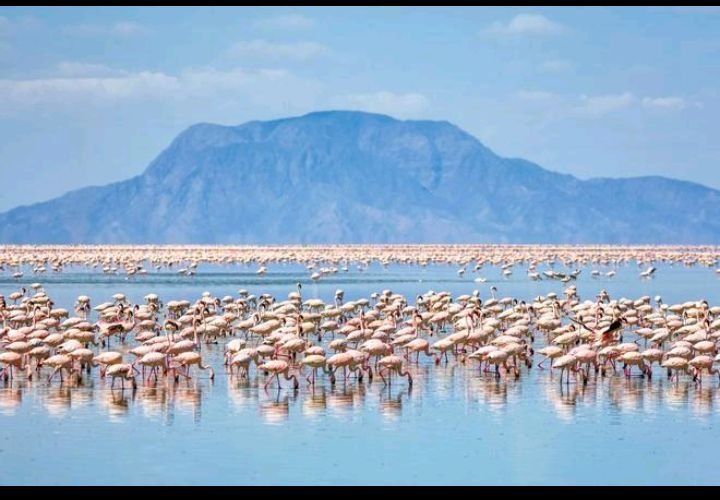Natron, el lago que petrifica aves/ Natron, the lake that petrifies birds
Versión en español
En el continente africano se esconde una fabulosa biodiversidad e inhóspitos paisajes. En Tanzania, un país de África Oriental se encuentra un lago con características muy peculiares, capaz de transformar la vida en piedra, en él la vida es casi inexistente, a excepción de unos pocos seres que se adaptaron a vivir en condiciones extremas. ¿Que tiene este lago que es tan extraordinario y que le concede la capacidad de “momificar” la vida? Si te interesan las curiosidades del mundo en que vivimos no busques más y acompañame a descubrir los secretos que en él se esconden.
Valle del Rift
El Gran Valle del Rift es probablemente el lugar donde el ser humano dio sus primeros pasos, aunque actualmente su naturaleza apenas permita vida en él. En sus tierras hay presente inmensidad de volcanes y una enorme grieta que se sigue extendiendo, y dentro de cientos de años se volverá una isla como lo es Madagascar.
Sobre este paisaje se pueden escribir cientos de publicaciones, pero en este caso me quiero centrar en una zona específica de él, antes mencionada, el Lago Natron.
Lago Natron y el por qué de la solidificacion
Este lago se asienta sobre un terreno precario y pantanoso, con un dificilísimo acceso. El paisaje está dominado por Ol Doinyo Lengai, un volcán activo que se encuentra justo al sur del lago Natron.
El lago tiene una longitud máxima de 56 km y una anchura de 22 km. El lago Natron se alimenta principalmente del río Ewaso Ng'iro del sur y de aguas termales ricas en minerales. Es uno de los lagos más extraños y sorprendentes de la tierra por su poder de petrificar a todo tipo de aves y animales terrestres que tocan sus aguas. La razón es simple, sus aguas son tan ricas en carbonato de sodio que ‘momifica’ a los animales que, accidentalmente y por su poder reflectante caen en sus aguas. Esto se debe a unas aguas que ascienden a una temperatura de 60 grados centígrados, y un pH alcalino de entre 9 y 10,5, es más que obvio que no es complicado morir tras un chapuzón en este lago, que debe su nombre a la sustancia que utilizaban para secar a las momias en el antiguo Egipto. Si una persona llegara a caer en sus aguas se petrificaria con el tiempo, incapaz de soportar las duras condiciones, y eso es lo que le pasa a muchas aves y murciélagos los cuales por la naturaleza reflectante del lago se confunden y caen en una trampa mortal.
¿Hay vida en este lago?
Aquí los únicos seres vivos que son capaces de habitar sus aguas son las algas de color rojizo, así como los peces alcolapia alcalica, que han conseguido adaptarse a sus duras condiciones. También es usual ver una bandada de flamencos enanos, que consumen sus algas filtrando las aguas alcalinas con su pico. Sorprendentemente, las aguas rosadas del lago son la única zona de reproducción regular en África Oriental para 2,5 millones de flamencos menores. Estas fascinantes criaturas han evolucionado para resistir el extremadamente alto contenido de sal del lago, lo que les permite reproducirse en un área libre de depredadores.
¿Cuándo es mejor visitar el lago?
La mejor época para visitar el lago Natrón es durante la estación seca, desde finales de mayo hasta principios de noviembre, ya que estos meses son un poco más fríos. La zona hace demasiado calor durante la corta estación seca de diciembre a febrero. En agosto, los flamencos comienzan a reunirse en el lago y continúan acumulándose hasta octubre. Visitarlo durante estos meses le brinda la oportunidad de ver esta espectacular reunión . La estación seca también ofrece mejores condiciones para realizar caminatas en los alrededores, ya que los senderos pueden ser peligrosos durante la estación húmeda. Durante la estación seca hay un mayor nivel de evaporación y esto aumenta la salinidad del lago. El aumento de la salinidad del lago hace que las cianobacterias se multipliquen a un ritmo más rápido, y esto le da al lago un tono rosado más intenso . Las cianobacterias proporcionan alimento a los flamencos. Sin duda alguna este es un lugar muy interesante que merece la pena visitar.
English version
The African continent hides a fabulous biodiversity and inhospitable landscapes. In Tanzania, a country in East Africa, there is a lake with very peculiar characteristics, capable of transforming life into stone, where life is almost nonexistent, except for a few beings that have adapted to live in extreme conditions. What is it about this lake that is so extraordinary and that gives it the ability to "mummify" life? If you are interested in the curiosities of the world we live in, look no further and join me to discover the secrets hidden in it.
Rift Valley
The Great Rift Valley is probably the place where the human being took his first steps, although nowadays its nature hardly allows life in it. In its lands there are immense volcanoes and a huge rift that continues to extend, and within hundreds of years it will become an island like Madagascar.
Hundreds of publications can be written about this landscape, but in this case I want to focus on a specific area of it, mentioned above, Lake Natron.
Lake Natron and the reason for solidification
This lake sits on precarious and marshy terrain, with very difficult access. The landscape is dominated by Ol Doinyo Lengai, an active volcano just south of Lake Natron.
The lake has a maximum length of 56 km and a width of 22 km. Lake Natron is fed mainly by the southern Ewaso Ng'iro River and mineral-rich hot springs. It is one of the strangest and most amazing lakes on earth because of its power to petrify all kinds of birds and land animals that touch its waters. The reason is simple, its waters are so rich in sodium carbonate that it 'mummifies' the animals that accidentally and due to its reflective power fall into its waters. This is due to waters that rise to a temperature of 60 degrees Celsius, and an alkaline pH of between 9 and 10.5, it is more than obvious that it is not complicated to die after a dip in this lake, which owes its name to the substance used to dry the mummies in ancient Egypt. If a person were to fall into its waters they would eventually become petrified, unable to withstand the harsh conditions, and that is what happens to many birds and bats which, due to the reflective nature of the lake, become confused and fall into a deadly trap.
Is there life in this lake?
Here the only living beings that are able to inhabit its waters are the reddish algae, as well as the alkaline alcolapia fish, which have managed to adapt to its harsh conditions. It is also common to see a flock of dwarf flamingos, which consume their algae by filtering the alkaline waters with their beaks. Surprisingly, the pink waters of the lake are the only regular breeding ground in East Africa for 2.5 million lesser flamingos. These fascinating creatures have evolved to withstand the extremely high salt content of the lake, allowing them to breed in an area free of predators.
When is it best to visit the lake?
The best time to visit Lake Natron is during the dry season, from late May to early November, as these months are a bit cooler. The area is too hot during the short dry season from December to February. In August, the flamingos begin to gather at the lake and continue to accumulate until October. Visiting during these months gives you the opportunity to see this spectacular gathering. The dry season also offers better conditions for hiking in the surrounding area, as the trails can be dangerous during the wet season. During the dry season there is a higher level of evaporation and this increases the salinity of the lake. The increased salinity of the lake causes the cyanobacteria to multiply at a faster rate, and this gives the lake a more intense pink hue. The cyanobacteria provide food for the flamingos. Undoubtedly this is a very interesting place worth visiting.
- Translate by DeepL




